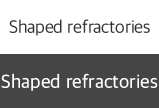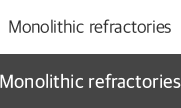Shaped refractories are produced by combining a range of appropriate materials into certain shapes, which are in turn heated or burned at high temperatures. Thus, shaped refractories resist against high temperatures or sudden thermal shocks and are characterized by stable volumes and high mechanical strengths. Also, shaped refractories will not react with gases, molten materials or solids and are free from erosion or abrasion.
| Product | Product name | Description |
|---|---|---|
| Alumina | Special Alumina Bricks | Made from high-purity synthetic alumina (alumina content: 99%+) and burnt at ultra-high temperatures, special lumina bricks are hardly physically deformed due to contraction and expansion at high temperatures, and characterized by superior hot volume tability, excellent chemical properties, erosion resistance, and stability in diverse atmospheres. |
| Special Alumina Bricks | Refined synthetic materials are used to minimize the content of foreign substances (alumina content:50%+). These bricks are burnt at high-temperatures. These bricks are widely used for hot air blast furnaces and non-ferrous metal melting furnaces due to stability in diverse gas settings and superior load softening resistance and creep resistance.. |
|
| High Alumina Bricks | With alumina content exceeding 50%, these bricks are made of natural alumina materials and undergo grain size controlling, high-pressure molding and high-temp burning, conforming to clients’ needs. Widely used for incinerators, cement plants and diverse atmosphere furnaces. |
|
| Fireclay | Fireclay Bricks | Most widely used for diverse furnaces, fireclay bricks contain alumina (25%~40%) and other fire clays as well as calcined chamotte. |
| Hard Fireclay Bricks | Fireclay and refined chamotte materials undergo high-temperature burning. Compared to ordinary clay bricks, these are characterized by fewer pores, denser textures and superior resistances against abrasion, creep and spalling, being widely used for diverse furnaces. | |
| Silicon carbide | Silicon Carbide Bricks | The main ingredient is non-oxide silicon carbide, which undergoes oxide, silicon nitride or self bondings. Characterized by high thermal conductivity, good resistance against spalling, abrasion, corrosion by non-oxide slag and chemical reaction with molten etals, silicon carbide bricks are widely used as lining materials for blast furnaces and non-ferrous metals. |
| Special | Special Bricks | Special bricks are used for special parts of diverse furnaces and undergo special processes fit for uses and attributes. |
| Acid-proof & heat-resistant | Acid-Proof and Heat-Resistant Bricks |
Used in acid-proof environment as lining materials or containers for sulfuric/hydrochloric acid processing units, these bricks have acid resistance in gases and solutions and heat resistance. |
| Insulating fire | Insulating Fire Bricks | Based on the low thermal conductivity of air, lots of pores are generated in fire-resisting materials for these bricks (porosity: 50~85%). Superior insulation properties reduce the furnace wall thickness, while increasing the in-furnace volume, saving construction and fuel costs. |
| Magcarbon | Magcarbon Bricks | Characterized by magnesia’s superior corrosion resistance, carbon’s high thermal conductivity, low thermal expansion, and non-wetting properties, magcarbon bricks are widely used for converters and secondary refining units. To keep carbon from oxidation, antioxidants are added. To reinforce spalling and corrosion resistances, pitch is used. |















